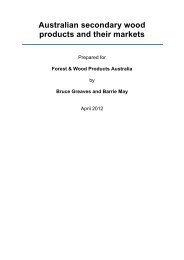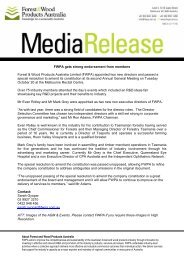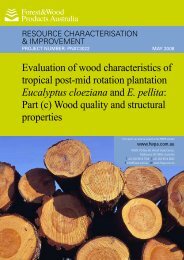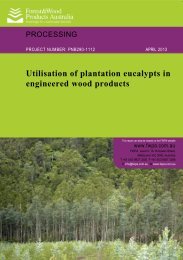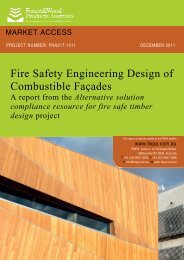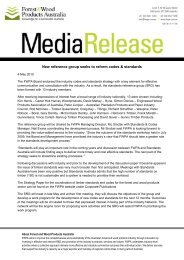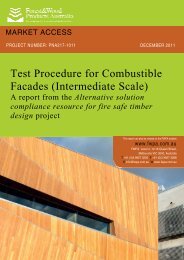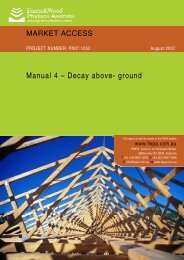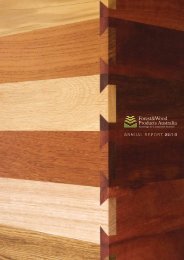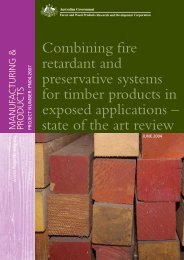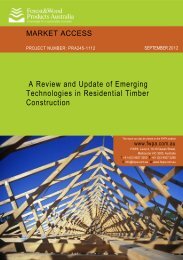guide to the specification, installation and use of preservative treated ...
guide to the specification, installation and use of preservative treated ...
guide to the specification, installation and use of preservative treated ...
You also want an ePaper? Increase the reach of your titles
YUMPU automatically turns print PDFs into web optimized ePapers that Google loves.
Page | 14<br />
GUIDE TO THE SPECIFICATION, INSTALLATION<br />
AND USE OF PRESERVATIVE TREATED<br />
ENGINEERED WOOD PRODUCTS<br />
Species with high natural resistance <strong>to</strong> marine borers, as listed in AS 5604. Only Class 1<br />
species <strong>use</strong>d in EWPs could be expected <strong>to</strong> give reasonable service life in nor<strong>the</strong>rn waters.<br />
Few wood species have high natural marine borer resistance, <strong>the</strong>refore supply <strong>of</strong> EWPs using<br />
appropriate species is unlikely.<br />
EWPs impregnated with chemical <strong>preservative</strong>s <strong>to</strong> AS/NZS1604.<br />
Chemical <strong>and</strong> or mechanical barriers.<br />
Chemical attack<br />
EWPs have a definite advantage over steel members when exposed <strong>to</strong> corrosive environments.<br />
Timber <strong>and</strong> wood products are able <strong>to</strong> withst<strong>and</strong> mild acid conditions <strong>and</strong> are more resistant <strong>to</strong><br />
degradation.<br />
The behaviour <strong>of</strong> EWPs in chemical environments depends upon a number <strong>of</strong> fac<strong>to</strong>rs, including<br />
timber species, pH <strong>and</strong> temperature. Wood essentially responds by ei<strong>the</strong>r swelling (Category S),<br />
similar <strong>to</strong> moisture response, or by chemical degradation (Category D). Damage due <strong>to</strong> swelling is<br />
essentially reversible, but chemical degradation results in breakdown <strong>of</strong> <strong>the</strong> wood structure <strong>and</strong> is<br />
non-reversible. Category S agents include alcohol <strong>and</strong> o<strong>the</strong>r polar agents. These agents swell dry<br />
wood causing a strength (<strong>and</strong> stiffness) loss proportional <strong>to</strong> <strong>the</strong> swelling. Category D agents include<br />
acids, alkalis <strong>and</strong> salts <strong>and</strong> result in a loss <strong>of</strong> strength <strong>and</strong> stiffness directly related <strong>to</strong> <strong>the</strong> loss <strong>of</strong><br />
member cross-section. Table 2 provides a rough <strong>guide</strong> <strong>to</strong> performance <strong>of</strong> EWPs in chemical<br />
environments.<br />
The effect <strong>of</strong> chemicals on wood will generally be worsened by increased exposure time, temperature,<br />
extremes <strong>of</strong> pH <strong>and</strong> chemical concentration. Wood generally <strong>of</strong>fers considerably less resistance <strong>to</strong><br />
alkalies than acids. S<strong>of</strong>twoods generally have better resistance <strong>to</strong> acids than hardwoods.<br />
Where <strong>the</strong>re is <strong>the</strong> possibility <strong>of</strong> chemical attack on EWP members, designers should seek expert<br />
advice.<br />
Agent<br />
category<br />
Table 2: Effect <strong>of</strong> chemicals on EWPs.<br />
Chemical agent Mode <strong>of</strong> attack Damage<br />
Reversible or<br />
Neutral Non-polar liquids such<br />
as petroleum<br />
hydrocarbons<br />
S Alcohol <strong>and</strong> o<strong>the</strong>r polar<br />
(swelling)<br />
solvents<br />
D<br />
Permanent<br />
Severity<br />
(loss <strong>of</strong> strength<br />
<strong>and</strong>/or stiffness)<br />
None Negligible Negligible<br />
Swelling Reversible Proportional <strong>to</strong><br />
volumetric swelling<br />
Inorganic acids Hydrolysis <strong>of</strong> Permanent Slight <strong>to</strong> moderate<br />
(degrading)<br />
cellulose<br />
D Organic acids such as: Hydrolysis <strong>of</strong> Permanent Slight (pH 3-6)<br />
Formic, acetic, propionic<br />
<strong>and</strong> lactic acid<br />
cellulose<br />
D Alkalis such as: sodium, Delignification Permanent Moderate (pH > 9.5)<br />
calcium <strong>and</strong> magnesium <strong>of</strong> wood <strong>and</strong><br />
hydroxide<br />
dissolving <strong>of</strong><br />
hemicellulose<br />
Severe (pH > 11)<br />
D Salts<br />
Hydrolysis <strong>of</strong> Permanent Slight<br />
(considered as weak<br />
acids)<br />
cellulose<br />
Note: Ref. Williamson, T.G. (Ed) 2002<br />
Corrosion <strong>of</strong> fasteners<br />
The correct selection <strong>of</strong> fastener type <strong>and</strong> material is important for <strong>the</strong> long term performance <strong>of</strong><br />
structures. Wood is slightly acidic in <strong>the</strong> range pH 3 <strong>to</strong> 6. In <strong>the</strong> presence <strong>of</strong> moisture, an acid<br />
environment is created posing a hazard for <strong>the</strong> fastener <strong>and</strong> surrounding wood material. Unprotected<br />
mild steel will corrode under <strong>the</strong>se conditions <strong>and</strong> will ca<strong>use</strong> a chemical reaction which also breaks<br />
down <strong>the</strong> surrounding wood.



